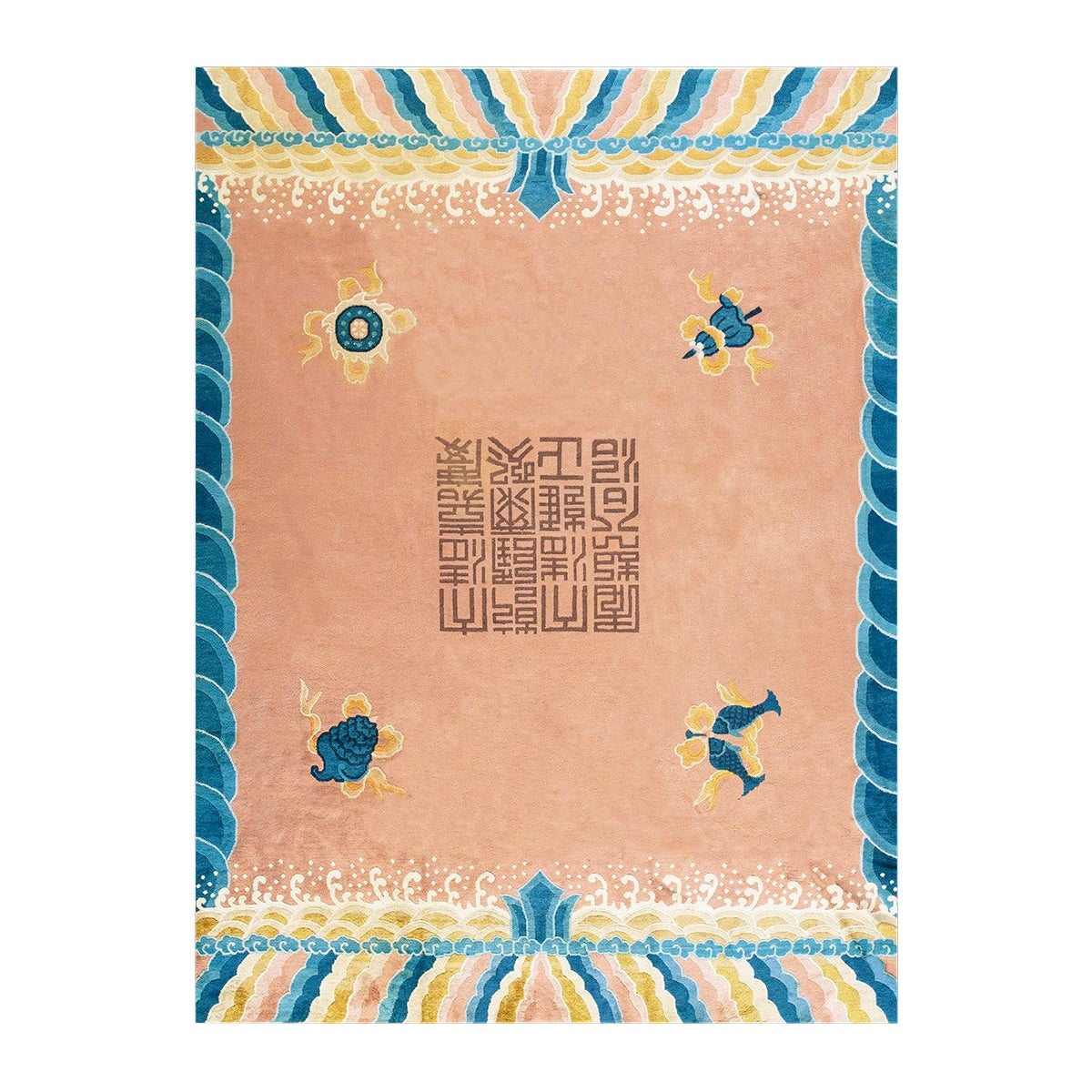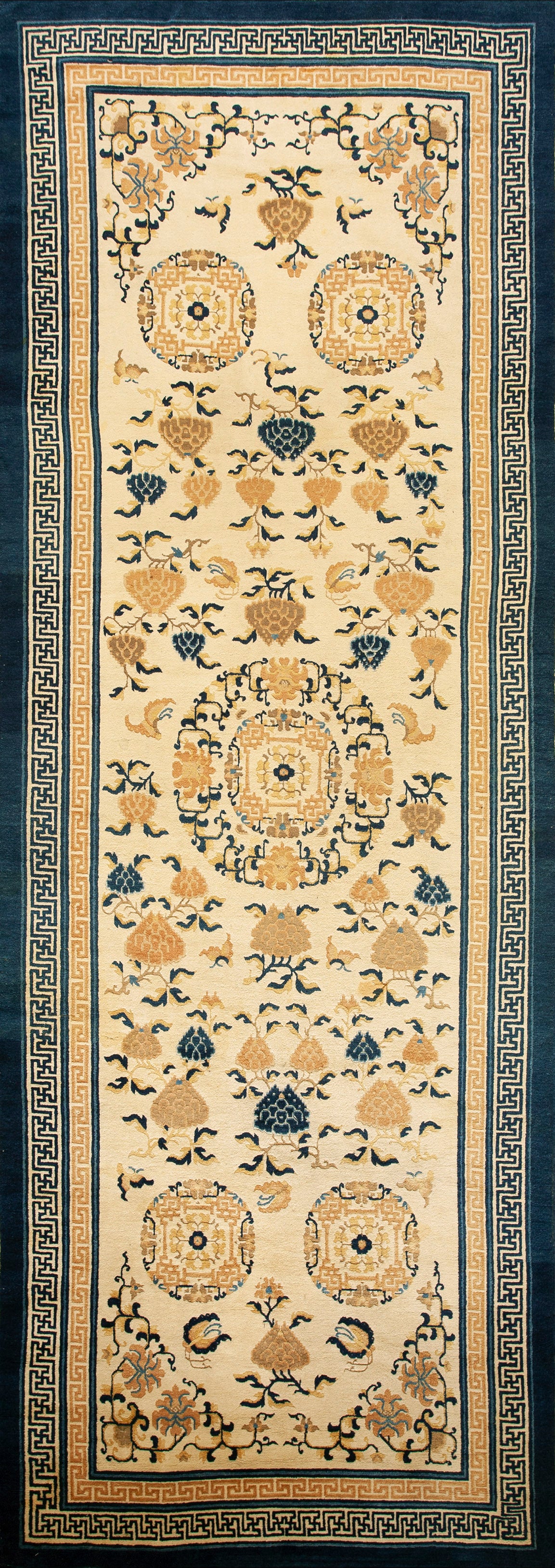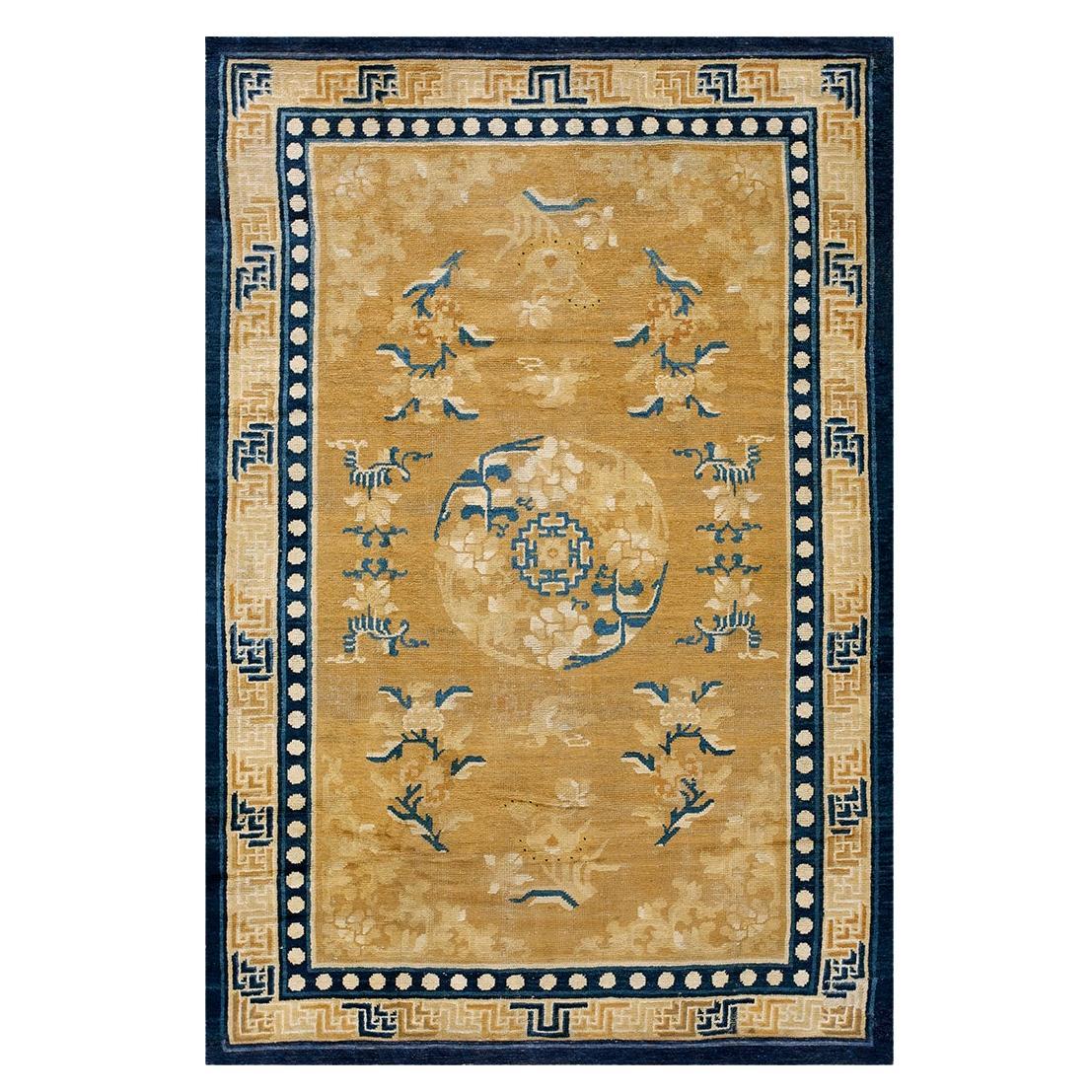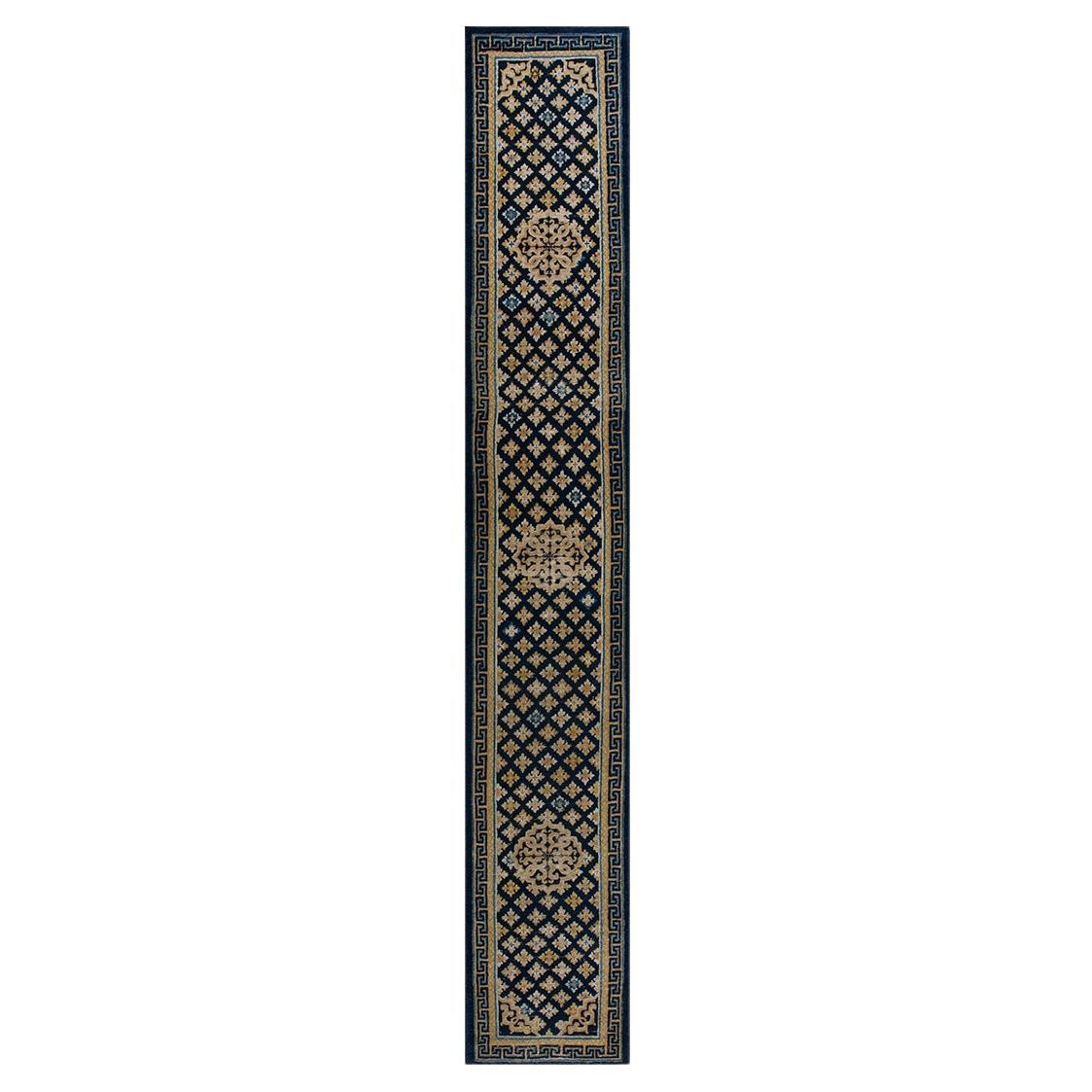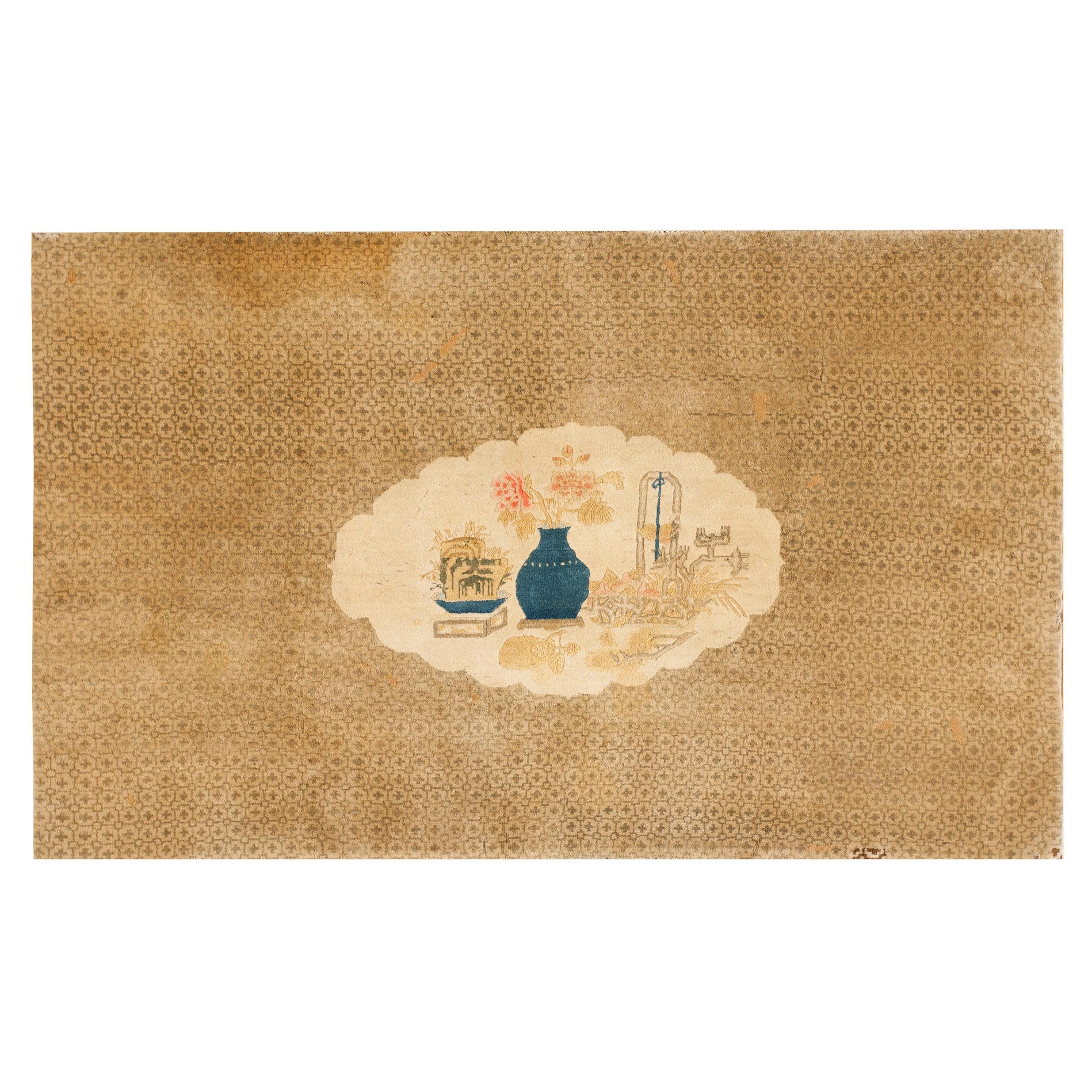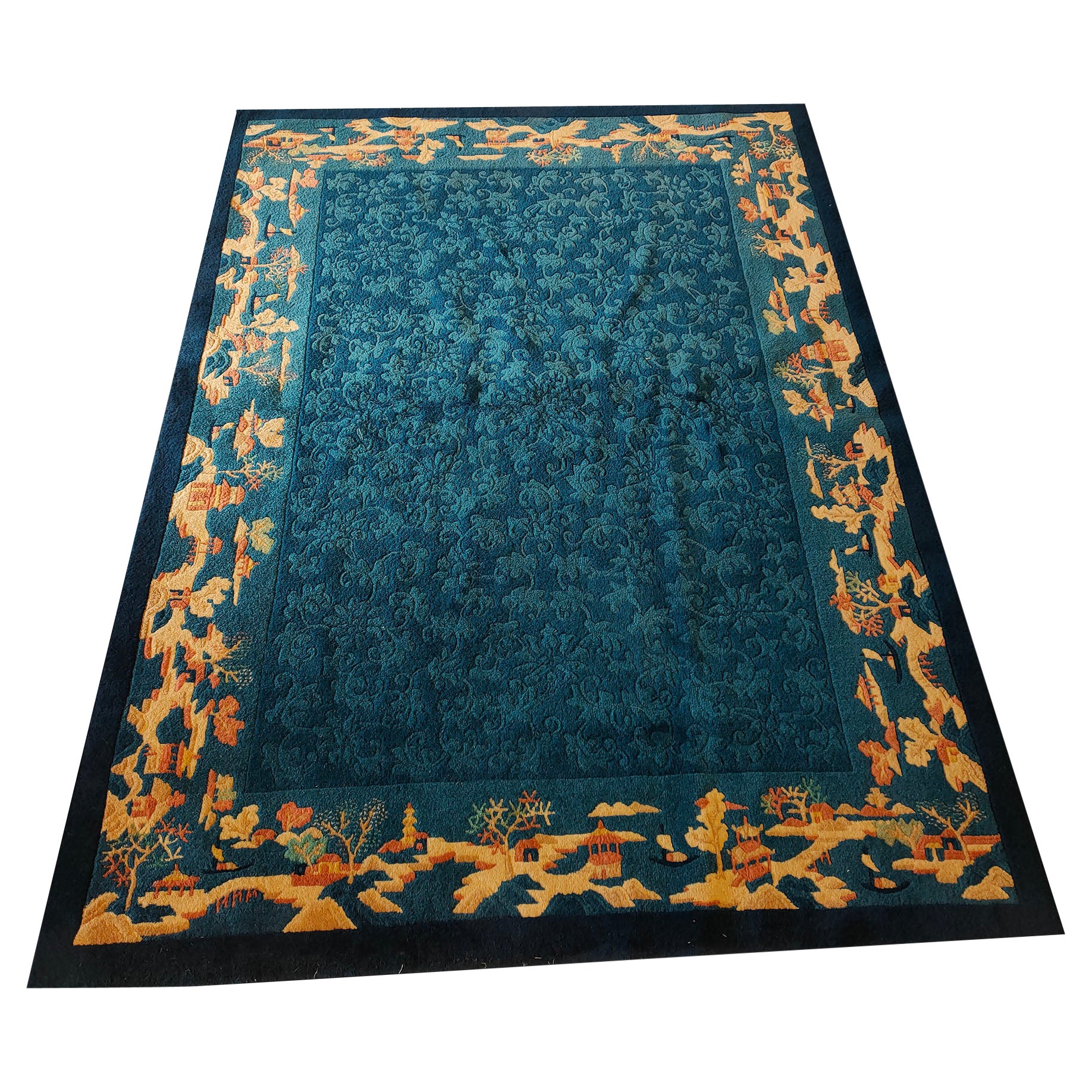Items Similar to Early 19th Century W. Ningxia Carpet ( 5'8'' x 6'10'' - 173 x 208 )
Want more images or videos?
Request additional images or videos from the seller
1 of 10
Early 19th Century W. Ningxia Carpet ( 5'8'' x 6'10'' - 173 x 208 )
About the Item
Ningxia rug, North Central China
5.8 6.10,
circa 1800.
Structural analysis:
Warp: Cotton, off-white, natural, Z-4-S, hand spun but tightly twisted;
Weft: Cotton, off-white, Z-3-S, winder plied, 2 shoots alternating, slack to wavy, some wefts quite thick’,
Pile: Wool, almost all Z-4,
Knot: PL/no alternate warp depression/ 6 ½ per horizontal inch x 6 per vertical inch = 39 per square inch,
Sides: Single body warp weft attached, wft wrapped, weft wedges into pole area;
Ends: Not original,
Weft/knots: 50/50 even ratio,
Pile wool somewhat dry, apricot high, yellow and light brown corroded.
This rug is one of a group of Ningxia pieces, all small, sharing the same palette and pattern. The design is a textile repeat of paeonies, trefoil leaves (or blossoms) and diagonal stems, here paired. The border is an “S” type of paeony palmette and short, leafy sprays, on a gold ground. A slightly smaller, but otherwise almost contemporary comparandum is Lorentz [ ], p.65, 4.5 6.2, with the same inner pearl border and doubled stems. They must come from the same workshop. In both pieces the groups of blue trefoil leaves are randomly scattered. The two rugs are so exact in their similarity that they may have been part of a larger order. In the Lorentz rug there are a few white field detains including a paeony, as well as a dark blue one. Both of these are absent in 21694.The drawing of the Lorentz example is slightly more curvilinear, but this is probably a shop variation rather than a sign of chronological priority. The weavers did not work from cartoons or detailed drawings in Ningxia and this variation is to be expected.
The pattern was obviously a commercial success and there are other contemporary examples known. A borderless (fragment?) piece is in the Textile Museum, Washington, D>C>, R.51.5 [fn.Eiland, 1979, p.].Here the paeonies are more internally detailed and the leafy sprays subtly curve. The floral array is denser and the regularity more obvious. The general effect is greater compactness than 21694. Eiland dates it to the early 19th century, but, like most of his overly conservative attributions, a late Ch’ien Lung period is probably acceptable. Another version, 4.5 x 6.2 was sold in the Jones sale, Anderson Galleries, NY, 18-19.4.1923, lot 165. This has a T-fret main border and a pearl inner. The field paeonies were all ivory and the stems curved noticeably. Bats interrupted the yellow T-fret major band. The rug was already worn and it sold for $90. The catalogue assigned it to the Qianlong period and this is quite correct.
- Dimensions:Width: 58 in (147.32 cm)Length: 72 in (182.88 cm)
- Materials and Techniques:Wool,Hand-Knotted
- Place of Origin:
- Period:1790-1799
- Date of Manufacture:1800
- Condition:Rewoven. Repaired. Wear consistent with age and use.
- Seller Location:New York, NY
- Reference Number:
About the Seller
4.8
Platinum Seller
These expertly vetted sellers are 1stDibs' most experienced sellers and are rated highest by our customers.
Established in 1995
1stDibs seller since 2019
344 sales on 1stDibs
Typical response time: <1 hour
- ShippingRetrieving quote...Ships From: New York, NY
- Return PolicyA return for this item may be initiated within 3 days of delivery.
More From This SellerView All
- Early 20th Century W. Chinese Ningxia Carpet ( 6'10" x 9'8" - 208 x 295 )Located in New York, NYEarly 20th Century W. Chinese Ningxia Carpet ( 6'10" x 9'8" - 208 x 295 )Category
Vintage 1910s Chinese Chinese and East Asian Rugs
MaterialsWool
- Mid 19th Century Chinese Ningxia Gallery Carpet (5'8" x 16'6" - 173 x 473 cm)Located in New York, NYMid 19th Century Chinese Ningxia Gallery Carpet (5'8" x 16'6" - 173 x 473 cm)Category
Antique 1840s Chinese Chinese and East Asian Rugs
MaterialsWool
- Late 18th Century Chinese Ningxia Carpet ( 4'10" x 6'10" - 147 x 208 )Located in New York, NYLate 18th Century Chinese Ningxia Carpet ( 4'10" x 6'10" - 147 x 208 )Category
Antique 1790s Chinese Chinese and East Asian Rugs
MaterialsWool
- Early 19th Century W. Ningxia Carpet 2' 2" x 13' 10"Located in New York, NYEarly 19th Century W. Ningxia Carpet Size: 2' 2" x 13' 10"Category
Antique 1750s Chinese Chinese and East Asian Rugs
MaterialsWool
- Early 20th Century Chinese Baotou Carpet ( 4 4" x 6'10" - 132 x 208 )Located in New York, NYEarly 20th Century Chinese Baotou Carpet ( 4 4" x 6'10" - 132 x 208 )Category
Antique Early 1900s Chinese Chinese and East Asian Rugs
MaterialsWool
- Early 20th Century Chinese Peking Carpet ( 5' x 6'10'' - 152 x 208 )Located in New York, NYEarly 20th Century Chinese Peking Carpet ( 5' x 6'10'' - 152 x 208 )Category
Vintage 1920s Chinese Chinese and East Asian Rugs
MaterialsWool
You May Also Like
- Antique Chinese Ningxia Carpet Rug, Late 19th CenturyLocated in San Francisco, CAAntique Chinese Ningxia Carpet Rug, Late 19th Century This elegant Chinese Ningxia carpet draws a central roundel composed of lotuses flanked by slightly smaller roundels of the sam...Category
Antique Late 19th Century Chinese Chinese and East Asian Rugs
MaterialsWool
- Antique Chinese Ningxia Rug, 19th CenturyLocated in San Francisco, CAAntique Chinese Ningxia Rug, 19th Century Antique Chinese Ningxia rugs are rare and collectible. They are hand-woven and feature nature-inspired motifs such as flowers, birds, drago...Category
Antique 19th Century Chinese Chinese and East Asian Rugs
MaterialsWool
- Ningxia, Dragon Rug Five Claws, 19th CenturyLocated in RÉDING, FRNingxia Dragon rug five claws, 19th century. Beijing in the Forbidden City of Ningxia !! Dragon pillar rug are used to decorate pillars in Buddh...Category
Early 20th Century Chinese Chinese and East Asian Rugs
MaterialsWool
- Antique Chinese Ningxia Mat Rug, 19th CenturyLocated in San Francisco, CAAntique Chinese Ningxia Mat Rug, 19th Century Areas of wear. Additional information: Dimension: 2'0" W x 2'1" L Origin: China Period: 19th Century (1st Half...Category
Antique 19th Century Chinese Chinese and East Asian Rugs
MaterialsWool
- Chinese Ningxia Throne Back Rug, 19th CenturyLocated in San Francisco, CAChinese Ningxia Throne Back Rug, 19th Century This classic Chinese throne back draws three five-clawed dragons against a golden ground. The bottom border has ‘magic mountain’ imager...Category
Antique 19th Century Chinese Chinese and East Asian Rugs
MaterialsWool
- 19th Century Chinese CarpetLocated in New York, NYChina, circa 1870. Floral design. Handwoven.Category
Antique 1870s Chinese Other Chinese and East Asian Rugs
MaterialsNatural Fiber
